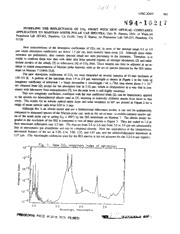
NASA Technical Reports Server (NTRS) 19940011744: Modeling the reflectance of CO2 frost with new optical constants: Application to Martian south polar cap spectra PDF
Preview NASA Technical Reports Server (NTRS) 19940011744: Modeling the reflectance of CO2 frost with new optical constants: Application to Martian south polar cap spectra
LPSC XXIV 601 N 94"16, 2 1 MODELING THE REFLECTANCE OF CO2 FROST WITH NEW OPTICAL CONSTANTS: APPLICATION TO MARTIAN SOUTH POLAR CAP SPECTRA, Gary B. Hansen, Univ. of Wash./Jet Propulsion Lab 183-601, Pasadena, CA 91109; Terry Z. Martin, Jet Propulsion Lab 169-237, Pasadena, CA 91109 New measurements of the absorption coefficients of CO2 ice, in most of the spectral range 0.2 to 3.9 _un where absorption coefficients are below 1.5 per cm, have recently been made [1]. Although these meas- urements are preliminary, they contain spectral detail not seen previously in the literature. Therefore, it is useful to combine these new data with older data from spectral regions of stronger absorption [2] and refor- mulate models of the albedo [3] or reflectance [4] of CO2 frost. These models can then be adjusted in an at- tempt to match measurements of Martian polar deposits, such as the set of spectra retumod by the IRS instru- ment on Mariner 7 (1969) [5,6]. The new absorption coefficients of CO2 ice were measured on several samples of 41-ram thickness at 150-155 K. A portion of the spectnml from 1.9 to 3.9 tun wavelength is sho/Wn in Figure 1 in the form of imaginary coefficient of refraction ( = linear absorption x wavelength / 47r )./The data above about 3 x 10.5 are obtained from [2], except for the absorption line at 3.32 gin, which is extrapolated in a way that is con- sistent with laboratory frost measurements [7], but the peak level is still highly uncertain. This new imaginary coefficient, combined with the real coefficient from [2], can be immediately applied to the models for hemispherical albedo used in [3], resulting in markedly different results from those in that study. The results for an infinite optical depth layer and solar incidence of 60° are plotted in Figure 2 for a range of mean particle radii from 0.03 to 3 nun. Although this is an albedo model and not a bidirectional reflectance model, it can still be qualitatively compared to measured spectra of the Martian polar cap, such as the set of near- to middle-infrared spectra tak- en of the south polar cap in spring (Ls = 200 °) by the IRS insmunent on Mariner 7. The albedo model de- graded to the resolution of the IRS is compared to two of these spectra in Figure 3. They are scaled to 1.0 at their maximum reflectance near 2.2 gin. The regions from 2.2 to 2.6 and from 3.0 to 3.9/am are substantially free of a0nospheric gas absorptions and can be compared directly. Note the coincidence of the characteristic absorption features of the ice at 2.28, 2.34, 3.00, 3.32, and 3.67 _Lm, and the albedo/reflectance maximum at 3.57 tun. (The wavelength calibration used for the IRS spectra is not yet accurate for the 2.2-2.6 kun region.) 10_I Fig. I" New C02 im?cjinory index of ref,roction 10-2 x io-3 m b ¢I r- "_ 10-4_ E n 10-5 -_ 10-6 _. 2.0I 2.5L t h i i 3.0I _ i i i 3.5I = Wovelength, micrometers f ,t _ PII_(:_ED_NIG PACE n, _,,,,. .... '_'_.", NOT FILMED 602 LPSC XXIV NEW MODEL REFLECTANCE OF CO2 FROST: Hansen, G.B., and T.Z. Martin Fig. 2: CO_ frost a!bedo, infinite optical depth, 60 ° incidence • • • , • i ." ' ;. • I • " " ' 0'i I " " Mean porticte rodu: 0.6 0.4 0.2 1 0.0 I. ¥,J, _ , , v L , , , 2.0 2.5 3.0 3.5 Wovelencjth, micrometers FiCl 3: Model olbedo of CO2 frost and two IRS soectro 1.0 "_ " _"_' .... ' .... ' ' ' " I,I • V \ f'! ,,o°oo. 1/% jl q meonro_,,s=3mm v , oo., £ /X ,,-'S \'\ /, , , , , " 0.0 I .... I , Y= ........ 2.0 2.5 3.0 3.5 Wavelencjth, micrometers The use of a reflectance model as well as the addition of water ice and/or dust contamination will be addressed in an effort to better match the observed spectra in this data set. In particular, the maximum at 2.2 i.tm, the slope from 2.3-2.6 jam, and the depression and muting of features at wavelengths longer than 2.9 pan are characteristic of water ice contamination as illustrated in [3]. This is a cooperative project of the University of Washington, Seattle, WA, and the Jet Propulsion La- boratory, Pasadena, CA, and is supported partly by a grant from NASA and partly by the Caltech President's Fund. REFERENCES: [1] Hansen, G.B. (1992), BAAS, 24, 978. [2] Warren, S.G. (1986), Appl. Opt., 25, 2650. [3] Warren, S.G. et al. (1990), JGR, 95, 14717. [4] Calvin, W.M. (1990), JGR, 95, 14743. [5] Pimentel, G.C. et al. (1974), JGR, 79, 1623. [6] Martin, T.Z. (1993), JGR, in press. [7] Fink, U. and G.T. Sill (1982), in Comets, L.L. Wilkening, ed., U. of Arizona Press, Tucson, 164.
